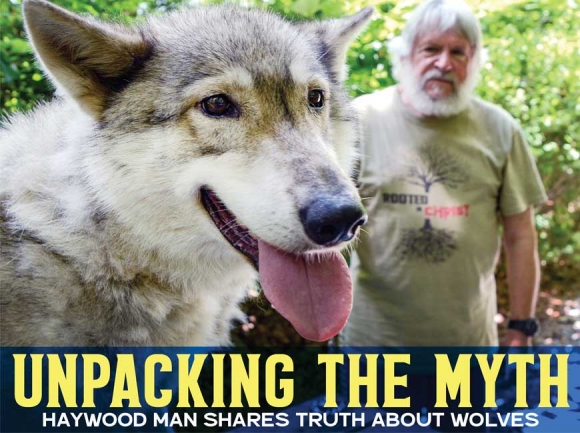Wolf Tales: Man and his wolf pack combat misunderstandings about America’s wild dog

Rob Gudger shares his Haywood County homestead with three canines and a housecat, but of the four the feline is the only one he considers a pet.
The canines live outside, get their sustenance in one massive feast per week, and give no visible indication that they know their names. That’s pretty well out of the normal for the life of a domestic dog, but the animals aren’t domestic dogs.
They’re wolves.
“They’re not a dog. They’re not a coyote,” said Gudger. “They’re a canine like the rest of them, but totally different.”
Gudger, 74, uses the wolves in environmental education presentations across the region — he calls the program “Wolf Tales” — and currently has three wolves. He estimates that, over the course of his 33 years handling them, he’s had a total of 10. The most he ever had at a time was four, and he keeps the wolves from the time they’re 6 weeks old until they die, usually at 10 to 12 years of age.
“People want to know are they trained or tamed. You can’t do either one,” he said. “It’s more of a socialize. They pretty much know what’s expected of them.”
Related Items

Rob Gudger (far left) and one of his wolves interact with the audience during a previous Mountain Wildlife Days event. Donated photo
Combating misunderstanding
Gudger, a resident of the Jonathan Creek area of Haywood County, has always had a strong interest in animals, attending N.C. State — incidentally, fans of the school are known as “the Wolfpack” — as an undergraduate student intent on becoming a veterinarian. He figured out along the way he wouldn’t be likely to make the cut as one of 30 people competing for eight vet school vacancies but ended up graduating with a degree in wildlife sciences.
He spent the next 25 years working for Duke Power as a mosquito abatement specialist stationed at Lake Jocassee and Lake Keowee. While mosquitoes were the focus during the summertime, in the winter he got to collaborate with the state wildlife guys.
“I had the best job in the world,” he said.
These days, Gudger works for the Great Smoky Mountains Association at Mingus Mill in the Great Smoky Mountains National Park, grinding cornmeal as a demonstration for visitors. He stayed with Duke until his position fell victim to downsizing in 1999. By that time, though, he was already hooked on wolves.
He’d acquired his first wolf during the 1980s following a Cherokee pow-wow he attended near Atlanta. Though Gudger himself is Caucasian, he’s long had a respect for and relationship with the Cherokee. During that pow-wow, a three-day event, he met a woman who was there with a pup — a wolf pup. They started talking and Gudger learned that she’d gotten the wolf from a Cherokee woman in Alabama who bred the animals. He was fascinated.
“I guess I got started because they were misunderstood,” said Gudger. He wanted to fix that.
Wolves have a reputation as being vicious killers, dangerous, always on the prowl. Conversely, some people think of them as basically dogs, just in need of a little taming. Both concepts are wrong, said Gudger.
“People mistake them for coyotes, and that’s not a good thing,” he said. “Coyotes, we have problems with inside the city limits and outside. They’re in 49 states now, and they’re not a wolf by any means. The wolf is a pack animal, a family animal, and is fairly docile compared to coyotes.”
Wolves don’t seek to attack humans, said Gudger. Instead, they avoid them. And while they will eat livestock if they need to, he asserted, they prefer natural prey.
Gray wolves used to range throughout much of what is now the United States and Canada, including the Southern Appalachians, but habitat destruction and intensive hunting — even bounty hunting, with rewards paid by a U.S. government bent on exterminating the species due to its predation on livestock — decimated the population. Gray wolves are now extinct in the eastern U.S. Thanks in some instances to reintroduction efforts, populations do currently exist in the northern Rockies, Pacific Northwest, Alaska, Canada and the Great Lakes region. Those populations have had positive effects on the overall ecology of their areas but have also met with opposition from ranchers who blame the wolves for killing livestock. The U.S Fish and Wildlife Service is currently evaluating a proposal to remove the gray wolf from the endangered species list.
North Carolina does have a small population of another native wolf species, the red wolf, but that population’s status has been in peril for some time. About 35 of the animals — the world’s only wild population — live in a five-county area of Eastern North Carolina. Reintroduction had been attempted in the Smokies in the 1990s, but failed. The eastern population initially grew, hitting a peak of 150 individuals about 10 years ago, but animals started getting shot by nighttime hunters who mistook them for coyotes.
This led to a lawsuit by environmental groups, which led to a ban on nighttime coyote hunting in the area. But then the Fish and Wildlife Service released a report concluding that the population was unsustainable, with a proposed rule released last year stating that the agency would stop managing the red wolves except for certain public lands in Hyde and Dare counties. In November, a federal judge struck down the rule as a violation of the agency’s mandate, and the Fish and Wildlife Service announced that it would extend its review of the proposed rule. No final decision has been reached.
Nowadays, the only wild dog species with any substantial population in the Eastern United States is the coyote, and it’s not native to the region — in fact, the N.C. Wildlife Resources Commission considers them an invasive species, placing no restrictions on when or how they can be hunted. There are plenty of people who are fine with that, as the animals cause all sorts of trouble, such as stealing livestock and killing pets like small dogs.
Coyotes arrived in North Carolina in the 1980s. Though prior to 1700 they lived only in the prairies and deserts of Mexico and central North America, today they can be found in every U.S. state except for Hawaii. According to a factsheet from the U.S. Department of Agriculture Animal and Plant Health Inspection Service, there are more coyotes today than when the U.S. Constitution was signed in 1787.
“We don’t have enough deterrents or predators for coyotes,” said Gudger. “The only predator the coyote has in the wild is the wolf, and we just don’t have enough of them.”
As much as he’d love to see gray wolves restored to this part of their natural range, said Gudger, there’s just not enough space for them. While red wolves are more tolerant of human interaction, gray wolves are more reclusive and need a home range of 50 to 100 square miles to wander without constantly running into people and roads. There’s no space like that in the eastern U.S. anymore.
“As far as the wolves being around, I’m all for it, but even the Smokies, they don’t have enough room where there are no people, no roads, no vehicles that the wolves could feel safe. And if they’re not safe they’re going to move somewhere,” he said.

Gudger and Wayah watch the water flowing through Jonathan Creek in Maggie Valley. Holly Kays photo
Independent minds
Gudger spoke during an interview conducted from a streamside picnic table in Maggie Valley, and he’d brought one of his wolves along as a living demonstration of what it means to be a member of the species Canus lupus.
Wayah, an 8-year-old female, had never been to a stream before, and she was fascinated, pulling Gudger along by the 6-foot chain whose end he held to arrive at the bank and then into the water, tromping around and sticking her snout into every crevice. When she straightened up, it was to take in some of the further-away details — a butterfly drifting along above the stream, a yellowed leaf falling lazily into the water.
“Nothing gets by her,” said Gudger. “It’s all about movement and shape.”
Wayah was mildly interested in meeting the stranger holding the camera and the voice recorder, but not overly so. She sniffed around, pushed her head up for a few scratches around the ears, and then moved on to investigating the remaining elements of her new surroundings. She’d perk up and pay attention to an unusual sound like a whistle, but calling her name drew no reaction.
Wolves are plenty smart, said Gudger. Their brains are bigger than those of domestic dogs, and it seems unlikely that they don’t know enough to recognize their names. It’s more likely, he said, that they just don’t care. Domestic dogs live to please their masters, but wolves aren’t interested in praise, or in being told what to do.
“You can make suggestions to them, but that’s about as far as it goes,” he said.
If Gudger had his way, he’d honor the wolves’ lack of domestication by not naming them at all. But, as he tells it, “Wolf” is not a satisfactory moniker for veterinary records. At least, not in English. His current animals are instead named “wolf” in the languages of the Cherokee, Delaware and Lakota-Sioux Indians. Those same names have been worn by different animals through the years — Gudger recycles the names as new wolves are born and old ones die.
Even though the wolves won’t take orders or come when called like a dog will, they’re predictable in their behavior. The wolves and Gudger have an agreement of sorts. He provides a comfortable, outdoor space for them to live — the one-acre enclosure sits at an elevation of 4,000 feet — food, veterinary care, three visits each day, and plenty of privacy. In return, they cooperate with, and even enjoy, the schedule of presentations and demonstrations he keeps, and they refrain from confirming any unwarranted stereotypes about wolf-kind. They’re not interested in hurting anybody, said Gudger, and he’s never had an issue with them being vicious toward a human.
Still, he doesn’t take any chances. The wolves are always on a chain when they’re outside of the enclosure, and he monitors each situation carefully.
“After 33 years there’s not a whole lot of surprises, but every program’s different,” he said. “Stressful might not be the word, but I’m in tune enough that I’m not totally relaxed. I’m careful about what’s going on.”
Gudger isn’t a member of the pack. He’s more like a neighbor, or a good friend. The kind of friend who comes bearing gifts in the form of 10-pound increments of chicken leg quarters.
“They always look like they’re thinking,” he said. “Well, they are thinking. They very rarely do things just on the spur of the moment. And they are protective of each other and their pups. As far as me, they’re not protective of me. I kind of wish they were sometimes.”
The wolves eat only once a week, mirroring the kind of diet they’d have in the wild. Wild wolves get most of their food from large animals like deer and moose and elk. It might take a pack three or four days to wear down the herd and make a kill, said Gudger, with several carcasses required to feed the whole pack. Wolves eat everything at one time, rather than burying extra food for later like some carnivores do. In the wild, a wolf might go two whole weeks without eating anything more substantial than a few mice.
His wolves get 10 pounds apiece of chicken leg quarters every Sunday evening. Within five minutes, the food is gone. It’s the perfect feast.
“Sometimes I’m negligent and don’t thaw it out quick enough,” said Gudger. “So they eat frozen chicken leg quarters. They tend to love that in the summertime. It’s like a popsicle.”

Wayah gives her handler a lick hello. Holly Kays photo
Meet a wolf
Rob Gudger brings one of his three wolves to Cataloochee Ranch to present every Friday night at 8 p.m. In return, the ranch donates to help pay the animals’ significant grocery bill.
Cataloochee serves dinner at 7 p.m., with reservations required. 828.926.1401.
Meet mountain wildlife
Rob Gudger and his wolves will be just some of the visitors at this year’s Mountain Wildlife Days, slated for July 12-13 at the Sapphire Resort Community Center.
“I try to set that week aside each year so that I can go up to Sapphire,” said Gudger, who’s been a presenter for about half of the event’s 16 years. “It helps promote wildlife programs. We get a lot of people in there for the event. There’s something different every day. There’s birds of prey, the wolves of course, reptiles, amphibians.”
The event will open in the morning on Friday, July 12, with a bird walk led by the Highlands Plateau Audubon Society. A pair of hikes to scenic locations and waterfalls led by experienced hike leaders Mike Kettles and Robin Lurie will be offered as well. Events are free, but group size is limited and reservations are required by calling 828.743.7663.
Friday afternoon, “Snake Man” Steve O’Neil will show off his reptiles and amphibians at the Sapphire Community Center, and at 6:30 p.m. a silent auction exhibit will open followed by bluegrass music from Benny Queen of the Wild Hog Band and Kelly Smith of Lost Chords at 7 p.m. The main event Friday will be “Bear Lady” Gaye Owen, who will present on how to get along with black bears.
The real fun begins at 10:30 a.m. Saturday with Live Animal Sharing. Naturalist Carlton Burke will present “Appalachian Wild” and a variety of his ‘wild lives’ at 10:30 a.m. After a short break, Gudger will bring two of his wolves and share his experiences with these important and misunderstood creatures at 11:30 a.m. The North Georgia Zoo will close the Saturday activities at 1:15 p.m. by showcasing unusual and familiar animals alike through its “Wildlife Wonders — A Zoo to You” program. Children and adults will have an opportunity to get up close to some of the zoo’s animals.
Fees are $5 for Friday evening and $8 for the entire day Saturday, with children admitted free. Proceeds fund wildlife education programs for children throughout the year. For more information, visit www.mountainwildlifedays.com or call the Sapphire Resort Community Center at 828.743.7663.









